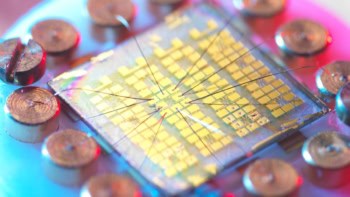A new technique that measures the orbital – rather than the spin – angular momentum of single photons could lead to the development of super-efficient quantum communication systems. Previously, physicists had only been able to measure this quantity for many photons in a beam, or detect a certain value of it for single photons. But the set-up devised by Miles Padgett of the University of Glasgow and colleagues should be able to reveal any orbital angular momentum state of a single photon (J Leach et al 2002 Phys. Rev. Lett. 88 257901).
Previous demonstrations of quantum communications systems based on photons used their spin angular momentum states to store information. There are two of these states, corresponding to the vertical and horizontal polarization of the spin, so a photon can take on a logical value of “1” or “0” to act as a quantum bit of information, or ‘qubit’. The photon can also exist in a ‘superposition’ of both states at the same time.
But the orbital angular momentum of a photon can take on an infinite number of values. Since a photon can also exist in a superposition of these states, it could – in principle – be encoded with an infinite amount of information. But so far physicists have failed to measure the orbital angular momentum of individual photons, and this has hindered attempts to use the state for data storage.
Now Padgett’s team has used a sequence of interferometers to sort single photons into four different orbital angular momentum states. They split a beam of light into two, rotated one of the resulting beams through 90° with respect to the other, and recombined them to produce an interference pattern.
If the original beam had an even value of orbital angular momentum, the beams interfered constructively, but if it had an odd value, they interfered destructively. This enabled the team to separate the photons with even and odd values of orbital angular momentum into two different detectors.
By passing both of these beams through the process again, the researchers separated photons into four different values of orbital angular momentum. Using filters, they also reduced the intensity of the beams so that on average, there was only one photon at a time present in each interferometer.
According to the researchers, this technique could – in theory – be extended to detect any number of different orbital angular momentum states, although they concede it could quickly become cumbersome. The Glasgow team now plans to refine its technique by using single-photon emitters and detectors.



